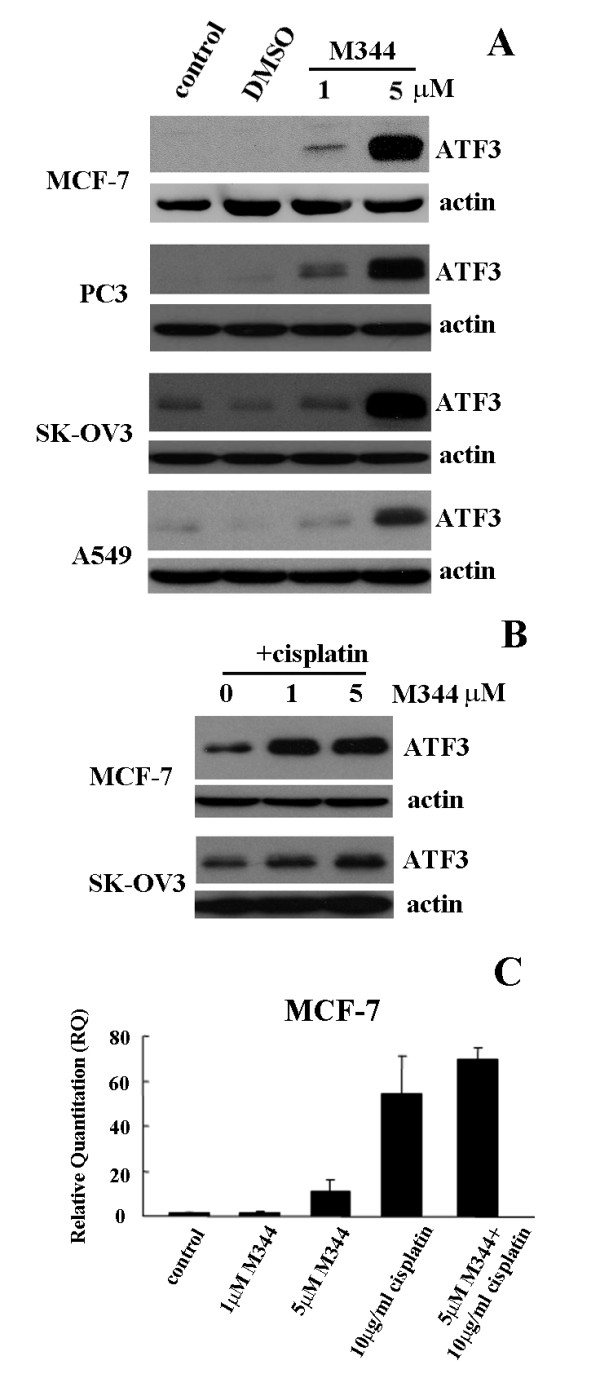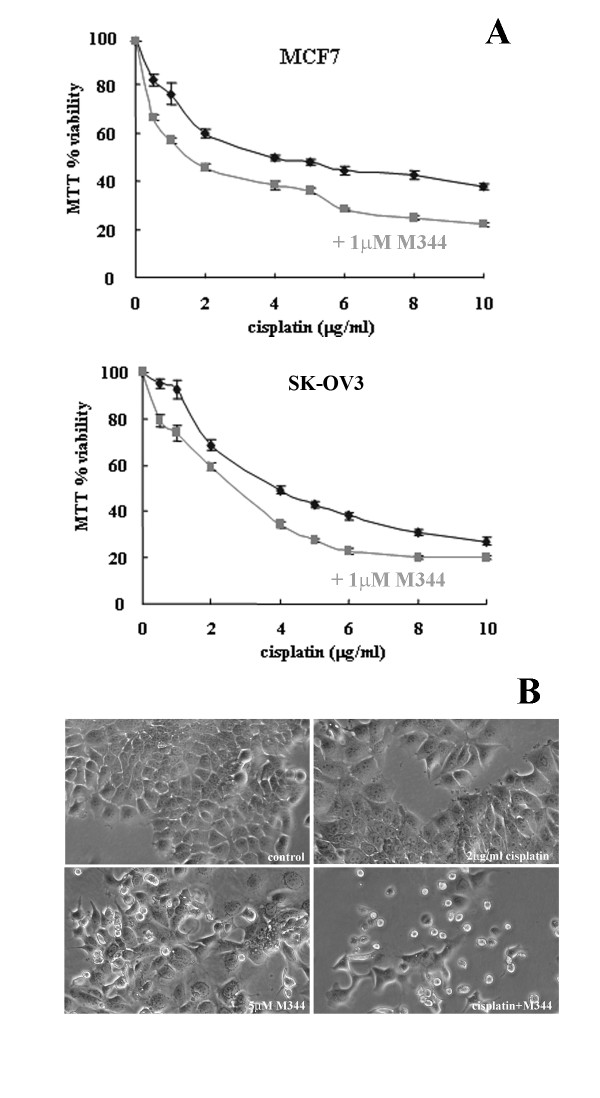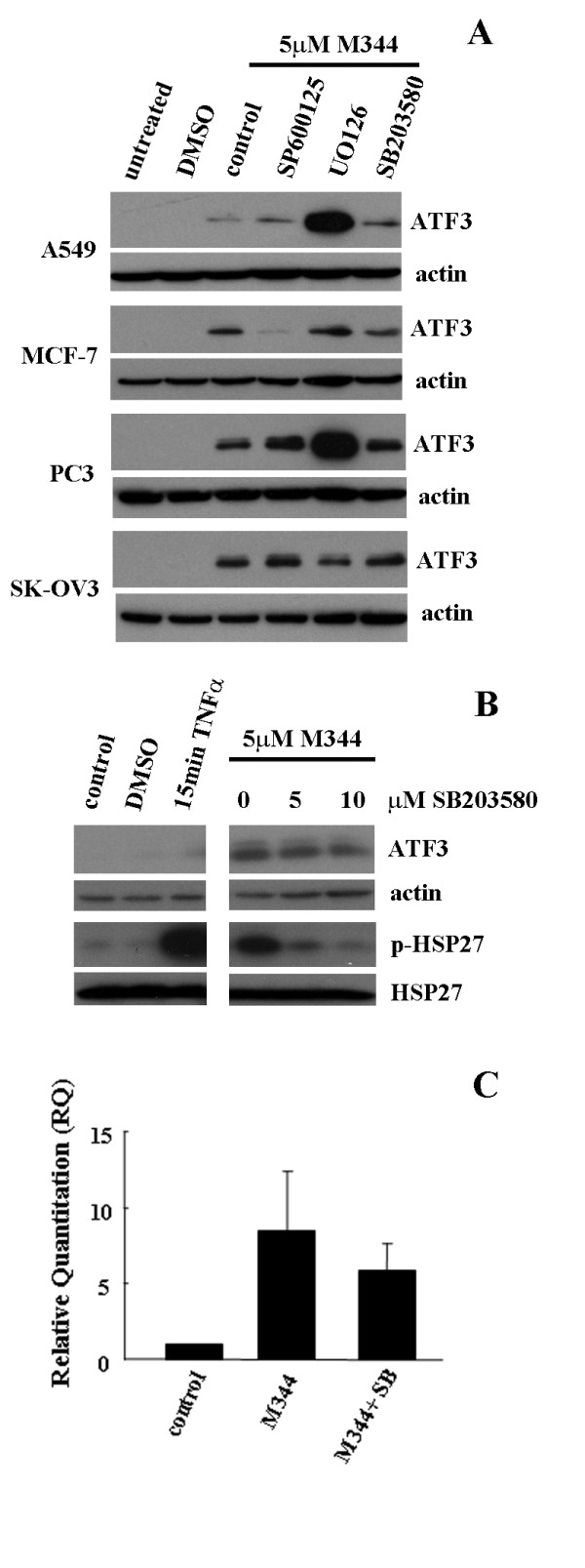
| Size | Price | Stock | Qty |
|---|---|---|---|
| 5mg |
|
||
| 10mg |
|
||
| 25mg |
|
||
| 50mg |
|
||
| 100mg |
|
||
| 250mg |
|
||
| 500mg |
|
||
| 1g |
|
||
| Other Sizes |
|
Purity: ≥98%
M344 (D-237; MS-344), an amide analogue of Trichostatin A, is a novel and potent pan-HDAC (histone deacetylase) inhibitor with potential anticancer activity. It exhibits strong anti-proliferative activity in vitro against a variety of cancer cell lines, including MCF-7 cells, and inhibits HDAC with an IC50 of 100 nM. Moreover, it can cause cell differentiation.
| Targets |
HDAC ( IC50 = 100 nM )
|
||
|---|---|---|---|
| ln Vitro |
|
||
| ln Vivo |
|
||
| Enzyme Assay |
The substrate for the enzyme is chicken core histones that have been radioactively labeled. Tritium acetic acid was released by the enzyme from the substrate, and scintillation counting is used to measure it. The outcomes of triple determinations are the IC50 values. For thirty minutes, 10 μL of total [3H]acetate-prelabeled chicken reticulocyte histones (1 mg/mL) are incubated with 50 μL of maize enzyme at 30 °C. 800 μL of ethyl acetate and 36 μL of 1 M HCl/0.4 M acetate are added to stop the reaction. An aliquot of 600 μL of the upper phase is centrifuged at 10,000 g for five minutes, and its radioactivity is measured in three milliliters of liquid scintillation cocktail. M344 is examined at a 40 μM initial concentration before the active ingredients are further diluted.
|
||
| Cell Assay |
The MEL DS19 cells, also known as murine erythroleukemia cells, are kept in D-MEM supplemented with 10% fetal bovine serum and 100 units/mL penicillin G sodium and 100 μg/mL streptomycin sulfate at 37 °C and 5% CO2. Log-phase cells with a population doubling time of 11–13 hours are used to test M344's ability to induce cell differentiation. M344 serial dilutions are made in 24-well plates with one milliliter (mL) of D-MEM per well. The same amount of solvent (usually 2 μL/mL of medium) is present in control wells if M344 are dissolved in DMSO. Then the wells are filled with the cell suspension. The experiment is assessed after seventy-two hours. With the use of a Casy 1 TTC flow cytometer, cell counts are determined. Percentage proliferation of treated cells compared to the solvent control is used to express the proliferation. Hemoglobin is accumulated by differentiated MEL cells. According to the literature, benzidine staining thus determines the induction of cell differentiation. Add 10 μL of a 0.4% benzidine solution in 12% acetic acid with 2% H2O2 to 100 μL of cell suspension. Hemoglobin-containing cells stain blue in five minutes. The percentage of positive cells is computed by counting both benzidine-positive and -negative cells in a hemocytometer under a microscope. Initially, M344 is examined at final concentrations of 10 μM and 50 μM. For a dose-response analysis, a range of concentrations is selected based on the activity/toxicity profile.
|
||
| Animal Protocol |
|
||
| References | |||
| Additional Infomation |
4-(dimethylamino)-N-[7-(hydroxyamino)-7-oxoheptyl]benzamide is a benzamide resulting from the formal condensation of the carboxy group of 4-(dimethylamino)benzoic acid with the amino group of 7-amino-N-hydroxyheptanamide. It is a potent inhibitor of histone deacetylases and induces cell cycle arrest and apoptosis in several human cancer cell lines. It has a role as an apoptosis inducer, an antineoplastic agent and an EC 3.5.1.98 (histone deacetylase) inhibitor. It is a member of benzamides, a hydroxamic acid, a secondary carboxamide and a tertiary amino compound.
A hydroxamic acid and anilide derivative that acts as a HISTONE DEACETYLASE inhibitor. It is used in the treatment of CUTANEOUS T-CELL LYMPHOMA and SEZARY SYNDROME. |
| Molecular Formula |
C16H25N3O3
|
|
|---|---|---|
| Molecular Weight |
307.39
|
|
| Exact Mass |
307.189
|
|
| CAS # |
251456-60-7
|
|
| Related CAS # |
|
|
| PubChem CID |
3994
|
|
| Appearance |
White to off-white solid powder
|
|
| Density |
1.1±0.1 g/cm3
|
|
| Melting Point |
161℃
|
|
| Index of Refraction |
1.558
|
|
| LogP |
1.06
|
|
| Hydrogen Bond Donor Count |
3
|
|
| Hydrogen Bond Acceptor Count |
4
|
|
| Rotatable Bond Count |
9
|
|
| Heavy Atom Count |
22
|
|
| Complexity |
340
|
|
| Defined Atom Stereocenter Count |
0
|
|
| InChi Key |
MXWDSZWTBOCWBK-UHFFFAOYSA-N
|
|
| InChi Code |
InChI=1S/C16H25N3O3/c1-19(2)14-10-8-13(9-11-14)16(21)17-12-6-4-3-5-7-15(20)18-22/h8-11,22H,3-7,12H2,1-2H3,(H,17,21)(H,18,20)
|
|
| Chemical Name |
4-(dimethylamino)-N-[7-(hydroxyamino)-7-oxoheptyl]benzamide
|
|
| Synonyms |
|
|
| HS Tariff Code |
2934.99.9001
|
|
| Storage |
Powder -20°C 3 years 4°C 2 years In solvent -80°C 6 months -20°C 1 month |
|
| Shipping Condition |
Room temperature (This product is stable at ambient temperature for a few days during ordinary shipping and time spent in Customs)
|
| Solubility (In Vitro) |
|
|||
|---|---|---|---|---|
| Solubility (In Vivo) |
Solubility in Formulation 1: ≥ 2.5 mg/mL (8.13 mM) (saturation unknown) in 10% DMSO + 40% PEG300 + 5% Tween80 + 45% Saline (add these co-solvents sequentially from left to right, and one by one), clear solution.
For example, if 1 mL of working solution is to be prepared, you can add 100 μL of 25.0 mg/mL clear DMSO stock solution to 400 μL PEG300 and mix evenly; then add 50 μL Tween-80 to the above solution and mix evenly; then add 450 μL normal saline to adjust the volume to 1 mL. Preparation of saline: Dissolve 0.9 g of sodium chloride in 100 mL ddH₂ O to obtain a clear solution. Solubility in Formulation 2: ≥ 2.5 mg/mL (8.13 mM) (saturation unknown) in 10% DMSO + 90% (20% SBE-β-CD in Saline) (add these co-solvents sequentially from left to right, and one by one), clear solution. For example, if 1 mL of working solution is to be prepared, you can add 100 μL of 25.0 mg/mL clear DMSO stock solution to 900 μL of 20% SBE-β-CD physiological saline solution and mix evenly. Preparation of 20% SBE-β-CD in Saline (4°C,1 week): Dissolve 2 g SBE-β-CD in 10 mL saline to obtain a clear solution. View More
Solubility in Formulation 3: ≥ 2.5 mg/mL (8.13 mM) (saturation unknown) in 10% DMSO + 90% Corn Oil (add these co-solvents sequentially from left to right, and one by one), clear solution. |
| Preparing Stock Solutions | 1 mg | 5 mg | 10 mg | |
| 1 mM | 3.2532 mL | 16.2660 mL | 32.5320 mL | |
| 5 mM | 0.6506 mL | 3.2532 mL | 6.5064 mL | |
| 10 mM | 0.3253 mL | 1.6266 mL | 3.2532 mL |
*Note: Please select an appropriate solvent for the preparation of stock solution based on your experiment needs. For most products, DMSO can be used for preparing stock solutions (e.g. 5 mM, 10 mM, or 20 mM concentration); some products with high aqueous solubility may be dissolved in water directly. Solubility information is available at the above Solubility Data section. Once the stock solution is prepared, aliquot it to routine usage volumes and store at -20°C or -80°C. Avoid repeated freeze and thaw cycles.
Calculation results
Working concentration: mg/mL;
Method for preparing DMSO stock solution: mg drug pre-dissolved in μL DMSO (stock solution concentration mg/mL). Please contact us first if the concentration exceeds the DMSO solubility of the batch of drug.
Method for preparing in vivo formulation::Take μL DMSO stock solution, next add μL PEG300, mix and clarify, next addμL Tween 80, mix and clarify, next add μL ddH2O,mix and clarify.
(1) Please be sure that the solution is clear before the addition of next solvent. Dissolution methods like vortex, ultrasound or warming and heat may be used to aid dissolving.
(2) Be sure to add the solvent(s) in order.
| NCT Number | Recruitment | interventions | Conditions | Sponsor/Collaborators | Start Date | Phases |
| NCT01281176 | Active Recruiting |
Drug: Carboplatin Drug: Vorinostat |
Adult Solid Neoplasm | National Cancer Institute (NCI) |
February 9, 2011 | Phase 1 |
| NCT00555399 | Active Recruiting |
Drug: Vorinostat Drug: Isotretinoin |
Glioblastoma Multiforme Anaplastic Glioma |
M.D. Anderson Cancer Center | November 28, 2007 | Phase 1 Phase 2 |
| NCT00616967 | Active Recruiting |
Drug: vorinostat Other: placebo |
Breast Cancer | Sidney Kimmel Comprehensive Cancer Center at Johns Hopkins |
May 2008 | Phase 2 |
| NCT03382834 | Active Recruiting |
Drug: Tamoxifen Drug: Vorinostat |
HIV Infections | National Institute of Allergy and Infectious Diseases (NIAID) |
April 26, 2018 | Phase 2 |
| NCT01236560 | Active Recruiting |
Drug: Vorinostat Drug: Temozolomide |
Brain Stem Glioma Cerebral Astrocytoma |
National Cancer Institute (NCI) |
November 15, 2010 | Phase 2 Phase 3 |
 |
|---|
 |
 |